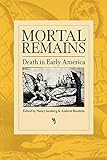Mortal Remains : Death in Early America / ed. by Andrew Burstein, Nancy Isenberg.
Material type: TextPublisher: Philadelphia : University of Pennsylvania Press, [2012]Copyright date: ©2003Description: 1 online resource (264 p.) : 20 illusContent type:
TextPublisher: Philadelphia : University of Pennsylvania Press, [2012]Copyright date: ©2003Description: 1 online resource (264 p.) : 20 illusContent type: - 9780812218237
- 9780812208061
- 306.9
- HQ1073.5.U6 ǂb M67 2003eb
- online - DeGruyter
- Issued also in print.
| Item type | Current library | Call number | URL | Status | Notes | Barcode | |
|---|---|---|---|---|---|---|---|
 eBook
eBook
|
Biblioteca "Angelicum" Pont. Univ. S.Tommaso d'Aquino Nuvola online | online - DeGruyter (Browse shelf(Opens below)) | Online access | Not for loan (Accesso limitato) | Accesso per gli utenti autorizzati / Access for authorized users | (dgr)9780812208061 |
Frontmatter -- Contents -- Illustrations -- Introduction -- Part I. Mortality for the Masses -- Chapter 1. The Christian Origins of the Vanishing Indian -- Chapter 2. Blood Will Out: Sensationalism, Horror, and the Roots of American Crime Literature -- Chapter 3. A Tale of Two Cities: Epidemics and the Rituals of Death in Eighteenth-Century Boston and Philadelphia -- Part II. The Politics of Death -- Chapter 4. Death and Satire: Dismembering the Body Politic -- Chapter 5. Immortalizing the Founding Fathers: The Excesses of Public Eulogy -- Chapter 6. The Politics of Tears: Death in the Early American Novel -- Part III. Physical Remains -- Chapter 7. Major Andre's Exhumation -- Chapter 8. Patriotic Remains: Bones of Contention in the Early Republic -- Chapter 9. A Peculiar Mark of Infamy: Dismemberment, Burial, and Rebelliousness in Slave Societies -- Part IV. After Life -- Chapter 10. Immortal Messengers: Angels, Gender, and Power in Early America -- Chapter 11. "In the Midst of Life we are in Death": Affliction and Religion in Antebellum New York -- Chapter 12. The Romantic Landscape: Washington Irving, Sleepy Hollow, and the Rural Cemetery Movement -- Notes -- Contributors -- Index
restricted access online access with authorization star
http://purl.org/coar/access_right/c_16ec
Mortal Remains introduces new methods of analyzing death and its crucial meanings over a 240-year period, from 1620 to 1860, untangling its influence on other forms of cultural expression, from religion and politics to race relations and the nature of war. In this volume historians and literary scholars join forces to explore how, in a medically primitive and politically evolving environment, mortality became an issue that was inseparable from national self-definition.Attempting to make sense of their suffering and loss while imagining a future of cultural permanence and spiritual value, early Americans crafted metaphors of death in particular ways that have shaped the national mythology. As the authors show, the American fascination with murder, dismembered bodies, and scenes of death, the allure of angel sightings, the rural cemetery movement, and the enshrinement of George Washington as a saintly father, constituted a distinct sensibility. Moreover, by exploring the idea of the vanishing Indian and the brutality of slavery, the authors demonstrate how a culture of violence and death had an early effect on the American collective consciousness.Mortal Remains draws on a range of primary sources-from personal diaries and public addresses, satire and accounts of sensational crime-and makes a needed contribution to neglected aspects of cultural history. It illustrates the profound ways in which experiences with death and the imagery associated with it became enmeshed in American society, politics, and culture.
Issued also in print.
Mode of access: Internet via World Wide Web.
In English.
Description based on online resource; title from PDF title page (publisher's Web site, viewed 24. Apr 2022)


